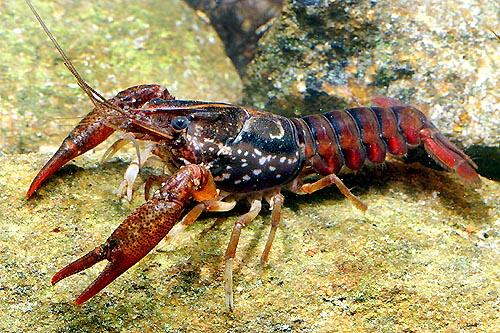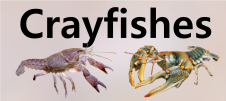







Loading profile. Please wait . . .
Procambarus enoplosternum Hobbs, 1947
Black Mottled Crayfish




Federal Protection: No US federal protection
State Protection: No Georgia state protection
Global Rank: G4G5
State Rank: S4S5
Element Locations Tracked in Biotics: No
SWAP 2015 Species of Greatest Conservation Need (SGCN): No
SWAP 2025 Species of Greatest Conservation Need (SGCN): No
2025 SGCN Priority Tier: None
Element Occurrences (EOs) in Georgia: 0
Habitat Summary for element in Georgia: Georgia habitat information not available
This crayfish exhibits two very different color patterns. The first has a dark carapace with cream colored splotches and a cream or orange central stripe. Beneath the dark base color it is possible to make out a darker saddle over the rear of the carapace which becomes forward pointing “horns” on the sides. The abdomen is blackish-red with lighter reddish spots on the lower sides of the abdominal segments. The claws are tan to brown with black tubercles. The alternate color pattern is much lighter with a tan or light brown carapace and abdomen; a pale central stripe on the carapace is still visible and this pattern exhibits the saddle and horns described above. However, in some populations of the lighter phase, the saddle is indistinct and the horns are reduced to two discrete spots. There is a single cervical spine on each side of the carapace and the rostrum is long with a distinct acumen and marginal spines or tubercles. The areola is wide. The species reaches a maximum total length of about 93 mm (3.7 in.).
Across its range, Black Mottled Crayfish has been collected with several other members of the genus Procambarus, including several closely related species. It differs from White Tubercled Crayfish (Procambarus spiculifer) and Ogeechee Crayfish (P. petersi) by having only one cervical spine on each side of the carapace as opposed to two on each side. Differs from White River Crawfish (P. acutus), Hummock Crayfish (P. lunzi), Eastern Red Swamp Crawfish (P. troglodytes), and Ornate Crayfish (P. howellae) by having a much wider areola. Lastly, it has occurred with Blackwater Crayfish (P. litosternum) which may be similar in appearance; details of the male reproductive structure will likely be required to separate these two species.
The Black Mottled Crayfish is primarily a stream dweller but has been found in simple burrows adjacent to streams and occasionally in temporary habitats (Hobbs 1981). In streams it is usually associated with some sort of cover, particularly vegetation and undercut banks. It may also be found in leaf litter or associated with rocks or woody debris.
No studies of the Black Mottled Crayfish are known. Crayfishes are considered opportunistic omnivores and likely feed on live and decaying vegetation, aquatic insect larvae, small fishes, and dead animal matter.
Stream dwelling crayfishes typically hide during the day and come out at night to feed. Reproduction usually occurs during the spring and fall, but males in reproductive condition may be found at any time during the year. When female crayfish are ready to lay eggs, they usually find a secure hiding place and hence are rarely encountered. When the eggs are released, the female attaches them to her swimmerets and is said to be “in berry.” Upon hatching, the juvenile crayfish are attached to the mother by a thread. After the juveniles molt for the second time, they are free of the mother, but stay close and will hold on to her for some time. Eventually they move off on their own. Crayfishes molt 6 or 7 times during their first year of life and most are probably able to reproduce by the end of that year. Male Black Mottled Crayfish in reproductive condition have been collected in Georgia and South Carolina in all months except January and December (Hobbs 1981). Females carrying eggs were found in March, April, May, June, and July and females with young found in April, May, and August. The smallest adult male known is about 29 mm (1.2 in) and the smallest female with eggs is about 48 mm (1.9 in) in length (Hobbs 1981).
Since this species is usually found in flowing water, it is most easily collected by holding a net perpendicular to the current downstream of vegetation or woody debris and kicking to dislodge and scare crayfish into the net. If there are rocks or logs in the creek, they may be carefully lifted and crayfish may be pinned by hand or coaxed into a dipnet. Using a backpack electroshocker or minnow traps can be effective as well.
The species is distributed from the Little Ocmulgee River system in Georgia eastward to the Santee River basin in South Carolina (Hobbs 1981). In Georgia is most commonly found in the Ohoopee and lower Oconee river systems.
The Black Mottled Crayfish is threatened in Georgia by land uses within its range that could alter hydrology and water quality. Introduction of non-native species is a threat to all native crayfishes.
This species is common and widespread and therefore is considered stable.
Conserving populations of the Black Mottled Crayfish will require general watershed level protection measures, including the protection of riparian zones, control of sediment and nutrient runoff from farms and construction sites, and limiting the amount of impervious cover (e.g., pavement) within occupied watersheds. Non-native crayfishes should never be used for bait; instead, anglers should use crayfishes collected from the river system where they will be fishing. Unused bait of any kind should not be released back into Georgia waters.
Hobbs, H.H., Jr. 1981. The crayfishes of Georgia. Smithsonian Contributions to Zoology 318:1–549.
Taylor, C.A., G.A. Schuster, J.E. Cooper, R.J. DiStefano, A.G. Eversole, P. Hamr, H.H. Hobbs III, H.W. Robison, C.E. Skelton, and R.F. Thoma. 2007. A reassessment of the conservation status of crayfishes of the United States and Canada after 10+ years of increased awareness. Fisheries 32:372–389.
Christopher E. Skelton
C. Skelton, August 2012: original account
C. Skelton, March 2019: general update of account.
D.Weiler, September 2019: photo added